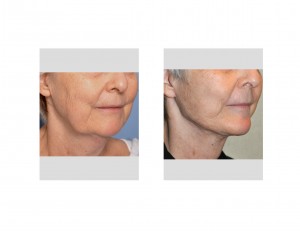Background: As the face ages the tissues above the jawline fall and descend over it. This ‘wax off the candle effect’ combined with a sagging neck create the need for a facelift procedure which reverses many of these facial aging effects. Contrary to the perception of many, a facelift only treats the lower third of the face and thus improves the shape of the neck and jawline
While a facelift reverses some of the effects of aging, what makes it fundamentally effective in the lower face is that it creates a more defined jawline. Or at the least it helps reshape the appearance of the jawline to the way it once was years before. By definition a more defined jawline helps create a more clear separation of the face from the neck.
But the effects of a facelift are apparent on the sides of the jawline from the body of the jaw back to its angles. A facelift has no effect on the central part of the face whether it is the soft tissues around the mouth or in helping to better define the chin. Creating improved chin projection, which can help create a better overall jawline appearance or to correct a naturally short chin, requires concurrent implant augmentation at the time of the facelift.
Case Study: This 62 year-old female wanted to improve her sagging jowl and neck. She had completely lost her once sharp neck angle and the jowling had obliterated her mid- jawline. She had a naturally shorter chin with a forward projection that was well behind a vertical line drawn down from her lips. When all these features were put together she had a facial profile in which an oblique line could be drawn from her nasal tip projection down through the forward chin connecting point and the soft tissues of the neck could almost contact this imaginary line.


Case Highlights:
1) One of the principle objectives of a lower facelift is to create a more defined jawline as that is one of the aesthetic facial features of youth.
2) Many patients who are considering or having lower facelift surgery have a mild to moderately weak chin projection.
3) Chin augmentation is a beneficial procedure that can be added to a lower facelift with minimal extra time and no prolongation of the recovery period.
Dr. Barry Eppley
Indianapolis, Indiana


